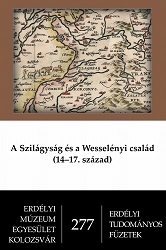A Wesselényi család nógrádi gyökerei
The Roots of the Wesselényi Family in the County of Nógrád
Author(s): Béla Pálmány
Subject(s): Local History / Microhistory
Published by: Erdélyi Múzeum-Egyesület
Summary/Abstract: The origin of the Wesselényi family – bearing the title of nobility “de Hadad” and “de Gyeke” and the rank of barony since 1582 – has been discussed by historians in the last two and a half centuries. This treatise recapitulates the different views on this question, reviews the research results of classical historians and publishes some unknown archival documents. The legendary of the family about the Czech ancestors (locality Wesseling in Bohemia) was accepted by the first Hungarian genealogists (László Mikola 1730, András Lehoczky 1796) but refuted by Iván Nagy, the founder of the scholarly genealogy in our country. Nagy was a native of Nógrád county, and he found documents in its archives, proving that members of the Wesselényi clan were possessors of estate Veselény in the 16th century. Also János Karácsonyi, the classic of heraldry contributed to the researches, when he found similarities between the coats of arms of the Wesselényi clan and that of Ladislaus Csese, a possessor in Dansa and Keresztúr (near to Veselény) in 1418 – and so he presumed kinship between their families, too. The author localizes the place name “Veselény” on the basis of the first maps of the former county of Nógrád (Antal Mocsáry 1826, Ignác Hátsek 1886). He also made a “discovery trip” to the locality, where he found 3 houses – the residents told the abode was called “Višilań”. In his former treatise (Restructuration of the Nobility of the county of Nógrád [1542–1848]) the author analysed some of the first state conscriptions of subsidium unius floreni (1542, 1548), where he found some members of the Wesselényi family. Now he made a thorough search and identificates their names and estates (a number of country houses): Nicolaus Wesseleny (possessor in Keresztúr/Nové Hony, Perenna and Kurtány) and the widows of Martin and Peter Wiseleni (possessors in Keresztúr respectively in Kurtány). Other known members of the family: Iohannes filius Stephani de Wyselen homo regius (1414), Stephanus filius Loranth de Wyselen (1449, 1461), Ladislaus de Wyselen (1461, 1469) solicitors, Petrus de Wysseleny (1517, 1526) castellan of Fülek/Fil’akovo, Susanna Wesseleny (1600 – married to George Sóry), the only daugther of Michael.The members of the Wesselényi clan played an active role in the struggle for power between the adherents of the Habsburg king, Ferdinand I respectively that of the Transylvanian reigning princes and Francis Bebek of Pelsőcz. The consequence was that Miklós (1504–1584) was declared a rebel and disobidient by Act 24:1556 of King Ferdinand I, and his estates in the counties Nógrád and Gömör were confiscated. At the same time – as a great jurist and influential politician of the Transylvanian Princedom – Nicholas was the great estate acquirer of the family, while Francis (1540–1594) the son of his brother Farkas (1502–1584) was made a baron in 1582. By that time the Wesselényi family had lost their estates in the county of Nógrád and became an influential aristocratic clan of Transylvania.
Book: A Szilágyság és a Wesselényi család (14–17. század)
- Page Range: 255-268
- Page Count: 13
- Publication Year: 2012
- Language: Hungarian
- Content File-PDF

